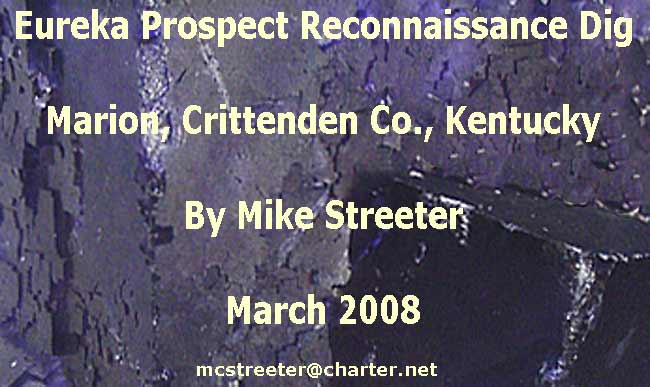When James Johnson proposed a field trip to the western Kentucky fluorospar district on the McRocks.com message board, there was quite a positive response as many were eager to add fluorite and other mineral specimens to their collections. The
Ben E. Clement Mineral Museum in Marion, Kentucky conducts fee-based field trips to local fluorite mines and prospects, including the Eureka and Columbia. The KYANA Geological Society of Louisville, Kentucky hosted a
Dixie Mineral Council field trip to the area in March 2007. In addition to fluorite, smithsonite, sphalerite, cerussite, galena, hemimorphite, hydrozincite, quartz, & pyromorphite may be found in spoil pile material.
Upon seeing that there were many other McRockers who were enthusiastic about a Marion field trip, James arranged with the Clement personnel to conduct a two-day McRocks dig there for May 10-11, 2008. He then reached out to Chrissy and me for assistance. Having led countless field trips ourselves, we know that first-hand knowledge is paramount to successfully leading a group to any location. Therefore, we suggested to James the importance of conducting a reconnaissance trip, so he arranged with the museum manager, Tina Walker, to visit the area in preparation of the larger group event. When asked by James, we were happy to put together a small "exploratory" team of diggers to join him there over the extended Easter holiday weekend. After all, who are we to turn down an opportunity to rockhound in a new location, especially since we had been looking for something to do during our 3-days off. A one-way 6-hour drive was perhaps a bit much considering the ridiculous gas prices, but James and the rocks were calling! Clement museum President, Bill Frazer, was to be our guide.
Chrissy, Opal and I arrived at the Clement museum at 8:00 AM Friday. Already
inside were James, Jeff Deere, Don Henderson,
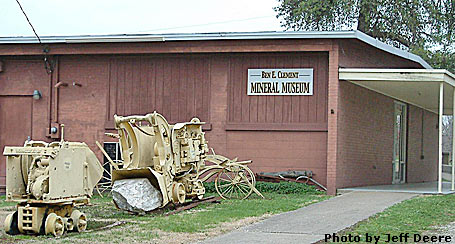 Bill Hayward and Mr. Frazer. We were quick to realize after meeting Mr. Frazer that we were going to get along just fine with him due to his good nature and excellent sense of humor. After signing the liability waiver forms and paying our fees, we all loaded up into our respective vehicles and followed Mr. Frazer who led us to the mine locations about 10 minutes from town. I suppose that I should mention now that the area received about 8-inches of rain within a 36-hour period just a couple days before we arrived, as an overabundance of water was a key factor in our two days of digging or, more accurately, attempting to relocate mud.
Bill Hayward and Mr. Frazer. We were quick to realize after meeting Mr. Frazer that we were going to get along just fine with him due to his good nature and excellent sense of humor. After signing the liability waiver forms and paying our fees, we all loaded up into our respective vehicles and followed Mr. Frazer who led us to the mine locations about 10 minutes from town. I suppose that I should mention now that the area received about 8-inches of rain within a 36-hour period just a couple days before we arrived, as an overabundance of water was a key factor in our two days of digging or, more accurately, attempting to relocate mud.
The Eureka Prospects and Columbia Mines are located in a hardwood forest alongside Hurricane Creek. On the far side of the creek are cow pastures.
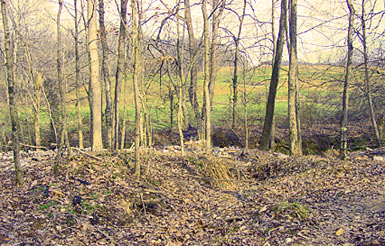
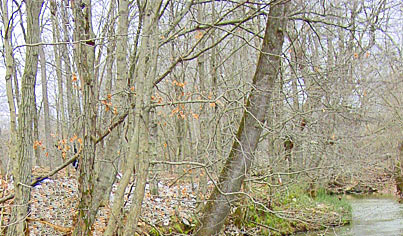
According to Mr. Frazer, the largest and best fluorite crystals have been found in the vicinity of Eureka Prospect. He directed us to the Eureka spoil piles and also pointed out a depression that he told us contained a collapsed mine shaft. Although not visible, this and the surrounding area is marked with a danger sign and is to be avoided because of the very real potential of a collapse that would swallow a rockhound.
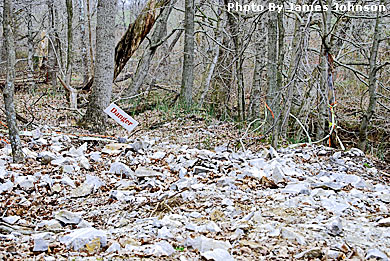
Mr. Frazer told us that we could surface collect in the Eureka spoil piles that extended from the creek into the forest. While the spoil piles nearest the creek have been laid bare by rockhounds with sledges, much of the older piles
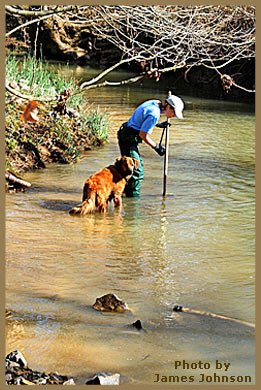 in the woods are covered with organic debris having not been touched in decades. Mr. Frazer also pointed out a pit adjacent to the creek that he had dug with a backhoe earlier in the year. According to him, many fine specimens had been recovered from the bottom of this pit. But, the aforementioned rain caused the creek's current flow to be at least 10-times its normal rate. During the rainstorm, mud and other debris were deposited in the pit and covered the bottom with many feet of saturated soil and leaf litter.
in the woods are covered with organic debris having not been touched in decades. Mr. Frazer also pointed out a pit adjacent to the creek that he had dug with a backhoe earlier in the year. According to him, many fine specimens had been recovered from the bottom of this pit. But, the aforementioned rain caused the creek's current flow to be at least 10-times its normal rate. During the rainstorm, mud and other debris were deposited in the pit and covered the bottom with many feet of saturated soil and leaf litter.
Never being one to back down from a challenge and generally preferring to dig rather than surface collect, Jeff, Don, Bill and I decided to see if we could excavate the goo from the bottom of the pit to reach the bedrock that Bill claimed contained a horizontal fluorite vein. A much wiser Chrissy and Opal opted to test the creek for goodies.
By the time that we finally gave up trying to evacuate slime from the pit, we were all covered from head to toe in mud. Our muscles ached from trying to dig down, lift up and throw unbelievably heavy shovels full of mud that mostly stuck like glue to our steel. Like quicksand, the mud would swallow us up if we
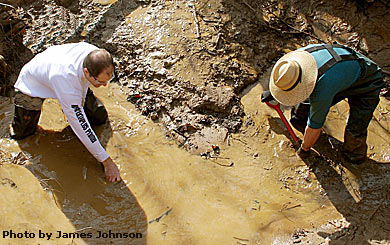 stepped into hidden depression or stood too long in any one spot, so we would have to ask for help just to free our legs and feet so that we could move. Having heard before the trip that some collecting can be done in the creek, Jeff and I purchased chest waders and these helped in the mud - at least until I ripped out my left knee and poked a hole in my right boot and the mud and brown water filled my boots. By early afternoon, we finally decided that it was futile to continue digging in the pit, so we gave up the fight and spread out to see what other options were available to us. Before we finished, we recovered a handful of what appeared to decent fluorite specimens from the spoil piles lining the muddy pit sides, but these required careful cobbing. By late afternoon, we had all managed to find a few keepers here and there. We divided the small pile that we had recovered while digging the pit and called it a day.
stepped into hidden depression or stood too long in any one spot, so we would have to ask for help just to free our legs and feet so that we could move. Having heard before the trip that some collecting can be done in the creek, Jeff and I purchased chest waders and these helped in the mud - at least until I ripped out my left knee and poked a hole in my right boot and the mud and brown water filled my boots. By early afternoon, we finally decided that it was futile to continue digging in the pit, so we gave up the fight and spread out to see what other options were available to us. Before we finished, we recovered a handful of what appeared to decent fluorite specimens from the spoil piles lining the muddy pit sides, but these required careful cobbing. By late afternoon, we had all managed to find a few keepers here and there. We divided the small pile that we had recovered while digging the pit and called it a day.
Usually, I'm not one to include anything about food in a field trip report, but, since this one is essentially for reconnaissance, here goes. The men enjoyed steaks and Chrissy a monster burrito at the Great Southwest Grill at I-24 exit 40 in Kuttawa. The location lived up to its name, serving great steaks and great food in a somewhat loud but not oppressive atmosphere. The noise was undoubtedly a function of the establishment being the only one within a 40-mile radius that serves alcohol. We were told Friday nights are much less rowdy than Saturdays. That's a scary thought because we had to holler across the table at one another just to be heard and had to settle for actually understanding maybe three out of four words.
We met at the Clement at 8:00 AM Saturday morning. We all decided to take the time to see the museum, as it is known to contain the finest display of fluorite in the entire world. Mr. Frazer was a terrific tour guide cheerfully taking us from room to room full of some of the most magnificent specimens of fluorite and associated minerals that I had ever seen or even thought could have existed. The museum is filled with an untold number of specimens that would be the envy of any collector and even the Smithsonian. Just about every turn of my head would result in seeing yet another breathtaking specimen. Jeff took the following excellent pictures that barely begin to show what the museum has to show on its seemingly countless display shelves.
